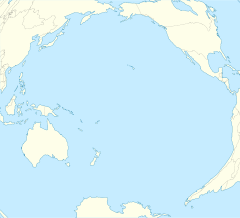geo.wikisort.org - Island
Darwin Island (Spanish: Isla Darwin) is among the smallest in the Galápagos Archipelago with an area of just one square kilometre (0.4 sq mi). It is named in honour of English scientist Charles Darwin. With no dry landing sites, Darwin Island's main attractions are found in the Pacific Ocean, which is teeming with a large variety of marine life. Although the island had been marked on maps and had initially been given the name Culpepper Island on Admiralty charts, the first landing on Darwin Island was not until 1964, by helicopter.[1]
 Darwin Island Location in the Galápagos Islands | |
| Geography | |
|---|---|
| Location | Galápagos Islands, Ecuador |
| Coordinates | 1.678°N 92.003°W |
| Archipelago | Galápagos Islands |
| Administration | |
Ecuador | |


The small detached group formed by Darwin Island and Wolf Island is sometimes referred to as Darwin and Wolf or Darwin-Wolf, formerly Culpepper and Wenman.
Geology
Darwin Island is the remains of an extinct volcano that reaches 165 metres (541 ft) above sea level. It is situated north-west of the main Galápagos Island group on the Wolf-Darwin Lineament, which extends from the Galápagos Platform to the Galápagos Spreading Centre, a mid-ocean ridge separating the Nazca and Cocos tectonic plates. The formation of Darwin Island is different from the formation of the main Galápagos Islands. There are currently two theories on the formation of the lineament: the first is that magma rising from the mantle plume forming the main Galápagos Islands has been channelled towards the Galápagos Spreading Centre; alternatively there has been a separate rise in magma caused by stress in the ocean lithosphere by a transform fault.[2]
Darwin Island is the most northerly of the two peaks on the Wolf Darwin Lineament that reach above the surface. The other, Wolf Island, is approximately 40 km (25 mi) away, although there are other sub-surface peaks. The volcano that forms the island is extinct, with the last eruption believed to have been approximately 400,000 years ago,[3] making it younger than Wolf. The lava flows around Darwin are homogenous, apparently because of its young age, and they have a similar chemical composition to those of the Galápagos Spreading Centre.[4]
Darwin is believed to have had at least two eruptive periods in its history, depositing two tuff layers separated by plagioclase ultraphyric basalt. Evidence also exists to suggest that Darwin Island is the remains of what was once a much larger edifice.[4] Since the eruptive phase this would have been eroded.
Darwin's Arch, a natural rock arch which would at one time have been part of this larger structure, was located less than a kilometre from the main Darwin Island, and it was a landmark well known to the island's few visitors, until its collapse in May 2021.[5]
Wildlife
Darwin Island is not open to land visits. As a result, the only visitors are those that come to scuba dive, even here due to the distance from the main island only a limited number of liveaboard ships cruise here. The marine life at Darwin is diverse with large schools of fish. The island's waters attract whale sharks from June to November, as well as hammerhead, Galápagos, silky and blacktip sharks. In addition green turtles, manta rays and dolphins can be found.[6]
The island also supports a large bird population, including frigatebirds, red-footed boobies and the vampire finch.
References
- Ecuador & the Galápagos Islands, by Danny Palmerlee, Michael Grosberg, Carolyn McCarthy. ISBN 1-74104-295-X
- Blair et al., Plume Ridge Interaction
- Cornell University
- Role of Plume-Ridge Interaction in Magma Genesis III: Darwin Island
- "Galapagos Islands: Erosion fells Darwin's Arch". BBC News. Retrieved 18 May 2021.
- "Galápagos National Park Interactive Map". Archived from the original on 2009-02-16. Retrieved 2009-02-13.
External links
На других языках
[de] Isla Darwin (Galápagos)
Isla Darwin (englisch Culpepper Island) ist eine unbewohnte Insel, die im äußersten Nordwesten der zu Ecuador gehörenden Galapagosinseln liegt und mit einer Fläche von knapp über 1 km² gleichzeitig die nördlichste und westlichste Insel des Archipels ist. Sie wurde nach Charles Darwin benannt und entstand vor etwa 700.000 Jahren.[3] Die nächstgelegene Insel ist Wolf und befindet sich 34 km weiter südlich. Auf der Insel leben viele Robben, Meeresleguane, Meeresschildkröten sowie zahlreiche Vogelarten, unter ihnen auch die Vampirfinken.- [en] Darwin Island
[es] Isla Darwin (Galápagos)
La isla Darwin (llamada antes isla Culpepper), es una isla ecuatoriana ubicada en el este del océano Pacífico que forma parte del archipiélago de las islas Galápagos. Esta isla fue nombrada así en honor a Charles Darwin, quien hizo famosas las islas a nivel mundial. Tiene una superficie de 1.1 km² (110 hectáreas) y una altura máxima de 168 metros.[1] Aquí habitan focas peleteras, fragatas, iguanas marinas, gaviotas de cola bifurcada, lobos marinos, ballenas, tortugas marinas, delfines, piqueros de patas rojas y enmascarados.[fr] Île Darwin (îles Galápagos)
L'île Darwin, en espagnol Isla Darwin, appelée aussi île Culpepper, est une île inhabitée d'Équateur située dans l'archipel des Galápagos. Son accès n'est pas autorisé aux visiteurs.[ru] Кулпеппер
Кулпеппер (Да́рвин)[3] (исп. Isla Darwin, Culpepper) — один из островов Галапагос, расположен на севере. Маленький, необитаемый остров с площадью немного более одного квадратного километра получил своё название в честь знаменитого британского натуралиста Чарлза Дарвина. На острове обитают многочисленные тюлени, морские игуаны, морские черепахи, а также разнообразные виды птиц.Другой контент может иметь иную лицензию. Перед использованием материалов сайта WikiSort.org внимательно изучите правила лицензирования конкретных элементов наполнения сайта.
WikiSort.org - проект по пересортировке и дополнению контента Википедии